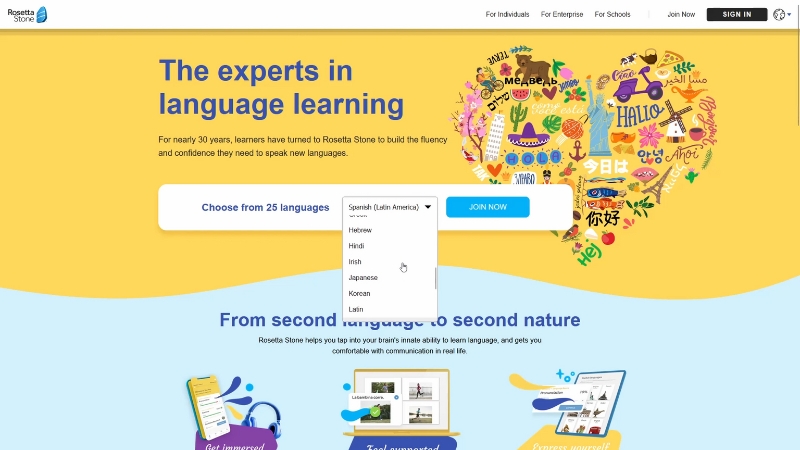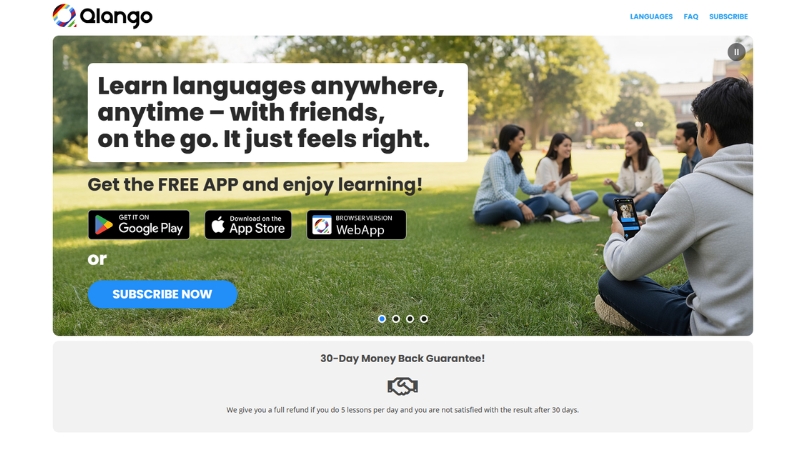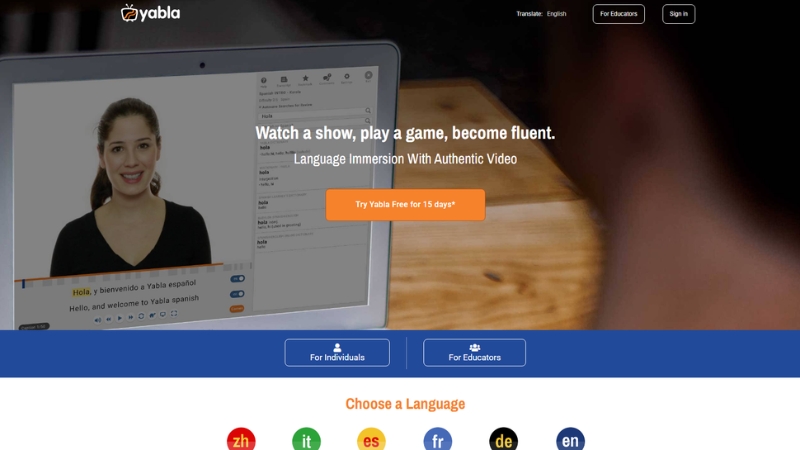Duolingo still rules the language learning app charts, but the world around it has caught up. What started as a fun way to collect streaks and peck through vocabulary lists now sits in the middle of a far more sophisticated ecosystem.
In 2025, learners will have options for grammar-heavy structure, exam-level progress, video immersion, and even CEFR certificates. Duolingo remains a great entry point, but the deeper end of language study belongs to other platforms.
Here’s a detailed look at the strongest Duolingo-style alternatives this year and what they actually offer beyond green owls and streak pressure.
Quick Comparison
| App | Best for | Languages (approx.) | Strengths in practice |
| Babbel | Structured conversation courses | 14 | Short lessons, clear grammar, strong beginner path |
| Busuu | CEFR structure + community feedback | 14 | Native feedback, certificates, big user base |
| Memrise | Real-life video and vocabulary | 20+ | Native clips, strong vocab training |
| Rosetta Stone | Full immersion and pronunciation | 25 | No translation, advanced speech tech |
| LingoDeer | Asian and grammar-heavy languages | 10+ | Script teaching, grammar foundation |
| Qlango | Game-like vocabulary for many languages | 50–70+ | Spaced repetition, direct target language responses |
| FluentU | Video immersion with subtitles | 9–10 | Real clips, strong listening and vocab |
| Yabla | Advanced authentic video | 6+ | Dual subtitles, precise playback tools |
| LingQ | Heavy reading and listening | 20+ | Imports real content, self-driven practice |
1. Babbel
Babbel acts like a proper course disguised as an app. Its pitch is simple: ten to fifteen minutes a day, all focused on useful conversation.
How it Works
- Lessons build logically from beginner (A1) upward. That sequencing follows the same core logic behind efficient language learning: frequent, structured repetition that moves knowledge from passive to active recall.
- Grammar is integrated, not avoided. Conjugations and sentence structure appear naturally inside dialogues.
- Learners practice through listening, speaking, and typing.
- Dialogues simulate real life: coffee orders, directions, small talk, job interviews.
Studies reported by the company claim over 90 percent of regular users see measurable progress in two months. The lessons follow a predictable structure, so it suits anyone who wants a plan, not just a streak.
Languages and Scope
Babbel offers around 14 major languages, covering English, Spanish, French, German, Italian, Portuguese, and more.
Depth varies, with richer content for European languages. Add-ons include podcasts, mini-articles, and “business” modules.
Value and Audience
Babbel charges subscription fees but runs frequent lifetime deals that drop long-term costs dramatically.
Reviewers usually rank it as the most structured, course-like option for people who actually want grammar and conversational balance without turning study into a game.
2. Busuu

Busuu takes the structure of Babbel and layers on a global community. Learners move through levels A1 to C1 and interact directly with native speakers for corrections.
Platform Setup
- Courses match official CEFR levels.
- Writing and audio exercises can be reviewed by native speakers.
- Built-in AI tools assist with grammar explanations.
- Community interaction is central; millions of feedback exchanges happen annually.
Certificates and recognition
Completing a course and passing its test earns a CEFR certificate. Those certificates can be added to LinkedIn or used for workplace verification.
Busuu markets them as digital proof of progress, particularly for professionals learning a second language.
Price and Positioning
With over 120 million registered users, Busuu stands as one of the largest global platforms. Independent comparisons in 2025 consistently put it among the best structured apps overall.
Learners who want accountability, grammar, and certification pick Busuu over Duolingo’s looser format.
3. Memrise
View this post on Instagram
Memrise looks and sounds different now than it did a few years ago. Gone are the chaotic user-made decks inside the main app.
What remains is a clean, video-heavy system built around short clips of native speakers saying real phrases.
Learning Flow
- Watch a video of a native speaker saying a phrase.
- Complete recognition or recall exercises.
- Reinforce phrases through spaced repetition.
- Hear authentic tone, slang, and rhythm, nothing robotic or studio-recorded.
Memrise sells itself as learning “the way people actually speak.” That’s not just marketing. The clips are street-level conversations, not textbook readings. It’s quick, visual, and human.
Best Use Case
Memrise is perfect for improving listening and natural phrasing. It’s weak for formal grammar or exams, but excellent for real-world comprehension.
Reviewers now label it a vocabulary and listening specialist rather than a full curriculum. It pairs well with a more structured app like Babbel or Busuu.
4. Rosetta Stone

Rosetta Stone has been around since the CD-ROM era, and it’s still alive, refined, and surprisingly modern. Its philosophy hasn’t changed: no translation, full immersion.
Method
- Teaches through pictures, context, and repetition instead of explanation.
- Includes TruAccent speech recognition for pronunciation feedback.
- Offers story-based practice and audio companions for offline learning.
The lessons move more slowly than in most modern apps, but go deeper into comprehension through context. You think in the language rather than mapping every sentence back to English.
Languages and Pricing
Rosetta Stone lists around 25 languages, including rare options like Dutch, Greek, and Arabic. Pricing leans toward subscription, but regular lifetime deals cut the cost heavily.
Who It Fits
Ideal for learners who want to train their ear and accent over grammar tables. It’s not built for fast progress but for deep, intuitive recognition.
5. LingoDeer
@samilearnskorean Have been recommending @LingoDeer: learn languages since day one of my Korean learning journey (for a good reason!) #learnkorean #studykorean #lingodeer #koreanlanguage #languagelearning ♬ original sound – Sami 세미
LingoDeer started small, focused on Japanese, Korean, and Chinese. It grew, but its heart remains in grammar and script-heavy languages.
Curriculum Design
- Lessons follow grammatical logic, not random word lists.
- Explanations cover particles, honorifics, and verb endings in clear English.
- Exercises test comprehension through structured examples.
- Built-in audio and script tracing for writing systems like Hangul, Hiragana, or Hanzi.
Where It Shines
Perfect for anyone tackling Japanese, Korean, or Chinese seriously. LingoDeer explains what Duolingo skips. Grammar is front and center.
For European languages, it’s solid, but it shines in East Asia’s linguistic complexity.
Weak Spots
Speaking and pronunciation practice are limited. It’s more workbook than a conversation app. But for grammar purists, it’s one of the strongest digital tools available.
6. Qlango

Qlango doesn’t chase flash or heavy marketing. It quietly serves those who like the game-like learning model but want more languages than any other app provides.
Core Features
- More than 60 languages, including smaller ones like Icelandic, Serbian, Georgian, and Kazakh.
- Multiple base languages (you don’t need to start from English).
- Users answer exclusively in the target language to train recall.
- Built on spaced repetition: thousands of high-frequency words with example sentences.
- Variety of quiz modes, including translation, dictation, sentence building, and matching.
Value Profile
Qlango runs on a lifetime purchase model instead of recurring subscriptions. The cost is often under 40 USD for full access, which is far cheaper than most competitors.
It focuses on vocabulary and sentence recall rather than full grammar lessons, making it perfect as a supplement to a main course app.
Ideal Learner
Best for multilingual hobbyists and travelers who want quick competence across multiple languages. Grammar is minimal, but retention rates are high due to spaced repetition and active recall.
7. FluentU
FluentU takes real media, including music videos, news reports, interviews, and trailers, and turns it into a study session.
How It Operates
- Every video comes with bilingual subtitles.
- Click a word to see definitions, examples, and usage patterns.
- The system creates flashcards automatically from words you’ve watched.
- Adaptive reviews reinforce vocabulary in context.
Supported Languages
Covers around ten major languages: English, Spanish, French, German, Chinese, Japanese, Korean, Russian, and Italian.
It’s content-rich and great for intermediate learners who want to hear how the language actually sounds outside a classroom.
Strengths and Limits
Excellent for listening comprehension and vocabulary in context. It’s less focused on grammar or formal testing.
Think of it as an immersion companion, what you open when you’re tired of drills and want to hear real people speak naturally.
8. Yabla

Yabla operates in a similar zone as FluentU but aims higher. It’s not an all-purpose beginner tool; it’s for learners who already know the basics.
Platform Features
- Curated video library with news, interviews, and cultural content.
- Dual-language subtitles with dictionary links.
- Adjustable playback speed and instant subtitle repeat.
- Integrated quizzes between segments.
Who Uses It
Teachers, advanced learners, and returning students who want authentic exposure without random YouTube searches. Yabla keeps its focus tight, only six to eight major languages, but with deep libraries for each.
Reviews consistently show strong satisfaction among long-term users who value real immersion and control.
9. LingQ
View this post on Instagram
LingQ goes heavy on volume. It lets you import your own material, articles, podcasts, ebooks, and learn from them directly.
Mechanics
- Words you’ve seen before appear in one color, unknown ones in another.
- Click a new word to save it as a “LingQ,” which becomes a flashcard.
- Review occurs automatically through spaced repetition.
- Built-in libraries of graded readers and podcasts are available for major languages.
Who Benefits Most
Independent learners who like freedom over structure. LingQ is essentially an environment for consuming vast amounts of text and audio while building vocabulary through exposure.
It’s not ideal for complete beginners but perfect once you’ve mastered the basics elsewhere.
Choosing the Right Duolingo Alternative in 2025
Every learner eventually hits the same wall with Duolingo: progress plateaus. The next step depends on what’s missing.
| Goal | Recommended App(s) |
| Strong grammar foundation | Babbel, LingoDeer |
| Structured path with certificates | Busuu |
| Real-world listening & slang | Memrise, FluentU |
| Pronunciation focus | Rosetta Stone |
| Broad language variety | Qlango |
| Advanced listening/reading | Yabla, LingQ |
Mixing tools makes sense. Many advanced learners use two apps at once: one for grammar and another for immersion. A Babbel–FluentU or Busuu–LingQ combo covers nearly every skill.
The Bigger Trend in 2025

Language learning apps now behave more like ecosystems than toys. AI is refining pronunciation feedback, adaptive spacing predicts memory curves, and CEFR frameworks are built directly into app structures.
The days of vocabulary-only apps are fading. Learners want measurable outcomes: certificates, test readiness, and real fluency.
Duolingo stays on top through sheer volume and accessibility. But serious learners in 2025 know better than to rely on one tool alone. Babbel offers structure. Busuu provides feedback. Memrise and FluentU bring immersion.
Qlango and LingQ expand their reach. Each carves out a niche Duolingo can’t fill, and together they form a complete garage of learning tools.
The era of collecting streaks is giving way to something more substantial: learning that actually sticks, sounds natural, and holds up in conversation. For anyone ready to move from green owl reminders to genuine language skills, the tools are already waiting.

